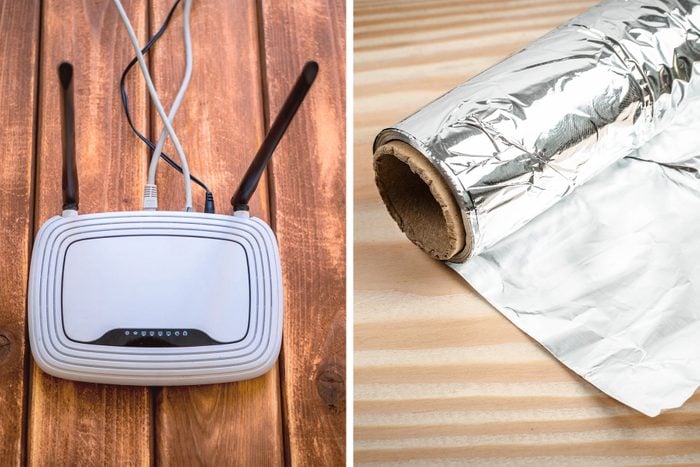Why You Should Be Putting Aluminum Foil Behind Your Router
Updated: Apr. 26, 2024

This surprising hack could be the remedy when your Wi-Fi throws a buffering tantrum—but is it the real deal or just another tech myth?
Imagine that it’s a cozy Friday night at home, and you’re all settled in to binge-watch your favorite show. You’ve got your snacks lined up, your comfiest blanket at the ready and the perfect spot on the couch. There’s just one problem: Your Wi-Fi signal is dragging.
In this age of instant streaming and virtual meetings, all of us are sadly way too familiar with that dreaded spinning wheel. But what if I told you there’s a science-approved tech tip that promises to put an end to your Wi-Fi woes, and the solution is a household staple that’s probably sitting in your kitchen right now?
Yes, you read that right. Turns out, boosting your Wi-Fi signal is one of many fascinating aluminum foil uses you never knew about. To get the inside scoop, I asked an expert to explain how this trick works and even grabbed my lab coat (aka my pajamas) to test it out. Thanks to a strategically placed sheet of aluminum foil, you just may be one step closer to banishing sluggish internet connections for good.
Get Reader’s Digest’s Read Up newsletter for more tech, travel, cleaning, humor and fun facts all week long.
How can aluminum foil boost a Wi-Fi signal?
The way this hack works is shockingly simple. But first, you need a little background on Wi-Fi signals: They come from the antenna on your router, which creates the connection with your smartphone, computer and other internet-connected electronics. To reach all the devices in your home, these signals behave like radio or light waves, spreading out to cover every available space—”like a sprinkler head spraying water in all directions,” according to tech expert James McQuiggan, a security awareness advocate at the online security platform KnowBe4.
Unfortunately, this can make the signals less efficient, weaken the connection and be one of the reasons your internet is slow. Not only does it send Wi-Fi signals to parts of your home where you don’t need it, but it can also lead to dead zones in certain areas where the signals can’t reach or are blocked by large obstructions like walls or floors.
By placing a curved sheet of aluminum foil around the router, you can shape the flow of the Wi-Fi signals more effectively. The shiny side of aluminum foil will reflect the beams coming from the antenna and point them at a specific place. From there, all you have to do is adjust the direction of the foil’s curve to steer the signal toward the parts of your home where you need better internet connection (like your living room, bedroom or office) or direct it away from spots where it would be wasted, like a window.
Does this actually work?
If you think this trick sounds too good to be true, we don’t blame you. But don’t just take our word for it—researchers at Dartmouth College vouch for it. When they tried it out for themselves, they found that using a reflective, curved surface like a soda can or a piece of aluminum foil could strengthen Wi-Fi signals in some spaces and weaken it in others, maximizing the coverage’s overall efficiency.
Still skeptical? In their paper, the researchers reported that their 3D-printed shape covered in aluminum foil, which they designed to match the specific Wi-Fi needs of the room, was able to boost wireless signals by up to 55.1% in certain spots, as well as reduce them by up to 63.3% in spots where Wi-Fi wasn’t needed. So there you have it!
Are there any other benefits to using aluminum foil with your router?
Strengthening your Wi-Fi speed isn’t the only perk of this handy hack—it can also boost your online security, according to the Dartmouth researchers. By limiting the reach of your Wi-Fi’s beams to the areas where you actually use it, you can reduce the risk that hackers will access the signal and attempt to steal your data. “Such physical confinement of wireless signals serves as a complementary method to existing network security measures, such as encryption, and hence raises the barrier for attackers,” the researchers wrote.
How to use aluminum foil to boost your Wi-Fi signal
Step 1: Gather your materials
Find a roll of aluminum foil, and cut a sheet to be approximately a foot long and the height of your Wi-Fi router. If your router has a physical antenna extending from the top, make sure the foil reaches a few inches above it. This won’t matter for routers that have an internal antenna.
Step 2: Fold the foil
Bend the foil to create a “C” shape, with the shiny side of the foil facing inside the curve. For routers with outer antennas, you might need to fold the top so that it covers the antennas too.
Step 3: Position the foil behind your router
Place the foil behind the router, with the curved portion facing toward the router and the target area where you want to boost the signal. You might need to fold the bottom part so that the aluminum foil can stand upright.
Step 4: Check your internet speed
Go to the targeted area, enter “Google speed test” into your phone or computer browser’s search bar and select the blue button that reads “run speed test.” The test will evaluate both the upload and download speeds of your internet connection and deliver a brief report.
Can you use other household staples for this purpose?
While aluminum foil is a lightweight, flexible and widely available option, it’s not the only item that can improve your Wi-Fi. Other common household metals—such as steel or copper baking sheets, or soda and beer cans—could be equally effective for this hack, McQuiggan says. Just make sure to position them so that the curved, reflective part faces toward the area in your home where you want to amplify the Wi-Fi.
Here’s what happened when I tried this Wi-Fi hack at home
I decided to put this aluminum-foil hack to the test from my porch, which is one spot in my home that always has a poor internet connection. Before I started, I compared the internet speeds between my porch and living room, where the router is located. The difference was massive: I got a download speed of only 30 Mbps from my porch versus 230 Mbps from my living room.
Now it was time to add the foil. After cutting a single sheet of aluminum foil, I folded it into a “C” shape, with the shiny side facing inward, and placed it beside my router, making sure the concave part faced toward my porch. When I went outside and ran the speed test again, the download speeds had slightly improved, bumping up to 35 Mbps. Meanwhile, the download speeds in my living room had dropped a little to 225 Mbps. I beefed up the test by adding two sheets of foil instead of just one, as well as replacing the foil with a soda can, but no dice. In fact, the two additional tests seemed to make my Wi-Fi speeds worse. Trying to load a Netflix show, for example, took a little bit longer than before.
Next, I tried this trick from my bedroom. Without the foil, download speeds in this room ran anywhere between 226 and 229 Mbps. One sheet of aluminum foil didn’t make any difference at all, and using two sheets of foil or the soda can seemed to drop speeds by a few Mbps. I tried adjusting the angle that the curved portion of the foil or can faced, as well as their locations beside the router, but I didn’t notice much of a difference with my internet speed when I tried to connect.
The verdict: Though it didn’t quite work for me, it can’t hurt to give this trick a shot before forking over significant cash for a Wi-Fi extender if you’re having internet connection problems. After all, it did work for the Dartmouth researchers. I would venture to guess that this hack might be more effective at improving your internet speeds depending on the size of your space, the number and type of obstructions between your router and device, and your internet plan.
Other options for boosting your Wi-Fi
Even if you strike out with this hack, fear not. McQuiggan notes that there are plenty of other fixes for sluggish Wi-Fi. “While foil can help concentrate the signals, it’s usually not a great solution compared with upgrading your router or positioning it more optimally,” he says. He recommends placing your router in a central, elevated location in your home without obstructions. You can also try other solutions, such as rebooting your router and checking the national broadband map, to improve your connection when you’re having an issue.
About the expert
- James McQuiggan is a Security Awareness Advocate for KnowBe4 and a part-time faculty professor at Valencia College in the Engineering, Computer Programming & Technology Division.
Source:
- Dartmouth.edu: “Customizing Indoor Wireless Coverage via 3D-Fabricated Reflectors”



